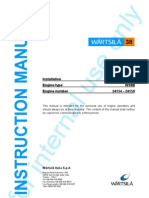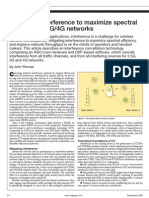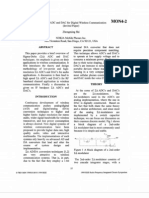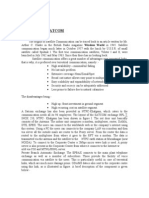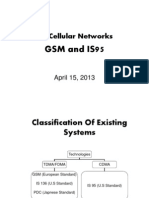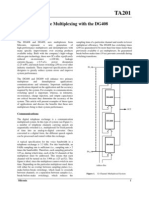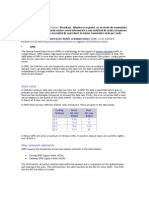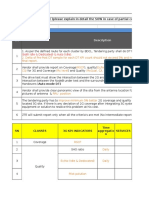Cdma Lsi Chip Set: A Compendium of Bipolar and Gaas Technologies
Cdma Lsi Chip Set: A Compendium of Bipolar and Gaas Technologies
Uploaded by
sbgayenOriginal Description:
Original Title
Copyright
Available Formats
Share this document
Did you find this document useful?
Is this content inappropriate?
Report this DocumentCopyright:
Available Formats
Cdma Lsi Chip Set: A Compendium of Bipolar and Gaas Technologies
Cdma Lsi Chip Set: A Compendium of Bipolar and Gaas Technologies
Uploaded by
sbgayenCopyright:
Available Formats
A Compendium of Bipolar and GaAs Technologies
CDMA LSI Chip Set
s Wide dynamic range, low noise s Single-chip CDMA*1 analog baseband ICs incorporating various analog technologies s On-chip automatic control filter with excellent temperature characteristics s Low-distortion, low-insertion loss antenna switch s Low-distortion, high-output power amplifier
With the recent remarkable advances in mobile communications technology, typified by digital cellular and cordless phones, the number of mobile communication subscribers is growing year by year. Special modulation techniques are used in digital communications to take full advantage of the excellent characteristics of digital signals. Frequency division and time division techniques are used in the familiar PHS and PDC systems, but many different digital systems are being established on a worldwide scale. In America, a growing movement emerged in 1989 in favor of general use of CDMA (code division multiple access)one kind of spread spectrum communication systemwith the aim of making efficient use of the frequency spectrum, one of mans most important natural resources. Today, CDMA is in use as one standard for car and portable phone systems. Although CDMA offers a number of excellent features, it requires much more complex signal processing than other systems, and this has kept it out of the consumer field so far. Behind the process of bringing CDMA to the consumer market lie the remarkable advances made in digital modulation, semiconductor process, and circuit technologies. In the digital communications field, Sony has already released a number of functional ICs such as PLLs, modulators, and mixers. Now, we are enhancing our CDMA IC lineup, employing a combination of bipolar and GaAs technologies.
What is CDMA?
CDMA is one kind of spread spectrum modulation system. The desired signal is modulated and transmitted by means of a key signal with a wider bandwidth than that required to transmit the desired signal. The features of this system are as follows: 1) As long as the key signals are different, demodulation can still be performed even if signals overlap, providing good multiplicity characteristics, unlike FDMA (frequency division multiple access) and TDMA (time division multiple access) in which demodulation is not possible if signals overlap. 2) Call security is protected, since the transmission can only be received if the key signal is known. 3) Since the spectrum is spread over a wide band, confidentiality is excellent, and there is no need for concern about communication to other parties. 4) Time resolution is high, since transmission is performed in a wider frequency band than the desired wave. 5) Interference resistance is good, since any interference is diffused in the demodulation process, giving a low noise level. With such outstanding characteristics, CDMA could well be called an ideal communication system.
CDMA Portable/Mobile Phone Systems
First, consider the signal flow during reception. Figure 1 shows a block diagram of a CDMA portable phone. The very weak receive signal from a base station is down-converted to the IF frequency band by the RF receiver, and amplified by the RX AGC unit. The IF signal is down-converted to an analog baseband signal by the analog baseband processor, and then the analog signal is converted to a digital signal. This digital signal is input to the mobile station modem where it undergoes CDMA demodulation, and is then output to the speaker via the CODEC. In transmission, an audio signal input from the microphone is converted to a digital signal by the CODEC, then undergoes CDMA modulation in the mobile station modem. The resulting
modulated digital baseband signal is converted to an analog baseband signal by the analog baseband processor, then up-converted to an IF signal before being output. This signal is input to the TX AGC unit where it undergoes output power control, and is then up-converted to the channel frequency in the RF transmitter before being output from the antenna. The next section describes in detail the light-blue ICs in figure 1 (the analog baseband processor and the RX AGC and TX AGC units), developed using a bipolar process.
Single-Chip CDMA Analog Baseband IC with 17,000 Elements CXA3003R
The CXA3003R is an analog baseband processor that interfaces between the digital processor and the RF front-end block. It supports dual-mode CDMA/ FM cellular phone systems. The CXA3003R includes a variety of functional modulesmodulator, demodulator, filters, A/D converters, D/A converters, PLL, VCO, etc.in a single chip, and might be described as a compendium of analog technologies. This IC uses a 0.8 ultrafine bipolar process (ECL4) to accommodate more than 17,000 elements, while achieving a low power consumption of only 132 mW in CDMA RXTX mode. The CDMA/FM signal flow is described in detail below.
The detailed information is opened only to the CDMA licensees.
Antenna RX AGC CXA3001N TX AGC CXA3002N
RF Transmit/receive processing
Baseband Analog Processor CXA3003R
Digital processing mobile station modem
CODEC
s Figure 1 Block Diagram of CDMA Portable Phone
1) CDMA Signal Processing
In the receiver, the CDMA spread spectrum modulated IF signal input to the CXA3003R via the RF front-end block is multiplied in the mixer block by an orthogonal local oscillator signal generated inside the CXA3003R. The signals pass through the CDMA low-pass filters and are converted to analog baseband signals, and are then converted into two 4-bit digital signals, I and Q, in the respective A/D converters, before being output.
In the transmitter, the CDMA I and Q digital baseband signals input to the CXA3003R from the digital processor pass through separate I and Q D/A converters and CDMA low-pass filters for the elimination of high-frequency components, and are converted to analog baseband signals. These signals are multiplied by an orthogonal local oscillator signal generated inside the IC, then added, and output as an I-plus-Q mixed CDMA spectrum modulated IF signal.
2) FM Signal Processing
In the receiver, the signal path is the same as for CDMA as far as the mixer block. After this, the signals pass through the FM low-pass filters and are converted to FM baseband signals, and are then converted into serial 8-bit digital signals before being output. In the FM transmitter, the FM digital baseband input signal input from the digital processor passes through the D/ A converter and FM low-pass filter, and is converted to an FM analog baseband signal. This signal modulates the transmit VCO frequency (130.38 MHz) and the result is output as an FM modulated signal.
Ref. CLK
gm tuning block
Trans-conductance filter
s Figure 3 Filter Block Configuration Diagram
Excellent Analog Filter Technology
The current service frequency band for CDMA is 800 MHz. Since this frequency band contains powerful waves generated by the AMPS analog FM mobile phone system, very stringent filter characteristic specifications are used to prevent interference from these waves. The provision of an on-chip automatic control filter configuration which determines the gm of the filters in the IC according to the input reference frequency, as shown in figure 3, results in a good frequency characteristic which is unaffected by either temperature fluctuations or element variations .
Wide Dynamic Range and Low Noise
As a basic principle, CDMA communication requires level adjustment of both receive and transmit signals using AGC. Reception AGC requires a wide input dynamic range, and transmission AGC, a wide output dynamic range. The gain control range in both cases is 80 dB or more, and this must also be achieved with a low noise level. The CXA3001N and CXA3002N are already on the market as CDMA cellular phone reception/transmission gain control amplifiers, offering performance on a par with the best in the industry, including a wide gain control range, excellent gain slope linearity, and dynamic characteristics unaffected by temperature fluctuations. Figure 5 shows the
CXA3001Ns gain control characteristic as an example of representative characteristic, and figure 7 shows the IIP3 of the CXA3001N. This concludes a summary of the relevant bipolar technology. The following description covers GaAs devices used in PCS (personal communication services), which is attracting attention as a next-generation mobile communication system. The GaAs devices are of low noise, low current, high gain and low parasitic capacitance. These features are suitable for the RF block of PCS as it uses extremely high frequencies in the semi-microwave band of 1.9GHz. An antenna switch is described here, as one example.
Sensitivity 60
VCC = 3.6V
40
20
Power Gain [dB]
-20
-40 Ta = -40deg Ta = 25deg Ta = 85deg -60 0 0.5 1 1.5 2 2.5 3 3.5
VGCTL [V]
s Figure 5 CXA3001N Gain Control Characteristic
IF Input CDMAIN for CDMA CDMAINX Switch Switch IF Input for FM FMIN FMINX OUT OUTX IF Output
Input Select Gain Control
MODE GCTL
BP1 to External Capacitor BP2
Supply Voltage
VCC 1, 2
Ground GND 1, 2 Power Save PSV
Bias driver
s Figure 6 CXA3001N Block Diagram
IIP3 0 -10 -20 -30 -40 -50 -60 -60 Ta = -40deg Ta = 25deg Ta = 85deg -40 -20 0 Power Gain [dB] 20
VCC = 3.6V
Low-Insertion Loss Antenna Switch CXG1012N
An antenna switch is used to switch between the internal antenna and a vehicle antenna or other external antenna (figure 8). Achieving low switching loss is an important consideration, since switching loss generally leads to a drop in reception sensitivity and increased power amplifier transmission output. Sony has solved these problems through the use of its proprietary low-distortion, low-insertion loss circuit technology and low-on-resistance GaAs JFET technology, in the shape of the CXG1012N. As shown in figure 9, the CXG1012N achieves a low-insertion loss figure of 0.5 dB or less with positive power supply control, and in terms of power characteristics, is capable of switching a signal of
IIP3 [dBm]
40
60
s Figure 7 CXA3001N IIP3
Antenna
Antenna LNA
PA Ext. CXG1012N Duplxer
s Figure 8 Example of External Antenna System Configuration
0 -2
Insertion loss
0 VCTL (H)=5V VCTL (H)=4V VCTL (H)=3V
Insertion Loss (dB)
-6 -20
VCTL (H)=3V VCTL (H)=4V VCTL (H)=5V
Isolation
@2GHz
-30
20
24
28
1W
32
36
40
Input Power (dBm)
s Figure 9 Input Power Dependency of Insertion Loss and Isolation in CXG1012N
1 W or less using 4 V control without loss of qualitya performance that places it in the top rank within the industry. In addition to this antenna switch, Sony is currently developing low-noise amplifiers, mixers, power amplifiers, and other products, which make full use of the single positive power supply operation which is a feature of Sonys pro-
prietary GaAs JFET technology.
Future Developments
A wide variety of digital communications systems are coming into use around the worldPDC in Japan,
CDMA in America, GSM in Europe. This article has described ICs for use in CDMA systems; in the future, Sony also plans to develop and release devices for other standard systems used in various parts of the world.
Isolation (dB)
-4
-10
You might also like
- Scene From "Proof" by David AubrunDocument11 pagesScene From "Proof" by David Aubrungenewng100% (2)
- W38 (9L38B) PDFDocument638 pagesW38 (9L38B) PDFantje6450% (6)
- Night Owl Optics Owners ManualDocument9 pagesNight Owl Optics Owners ManualKit100% (1)
- Indoor Radio Planning: A Practical Guide for 2G, 3G and 4GFrom EverandIndoor Radio Planning: A Practical Guide for 2G, 3G and 4GRating: 5 out of 5 stars5/5 (1)
- From GSM to LTE-Advanced Pro and 5G: An Introduction to Mobile Networks and Mobile BroadbandFrom EverandFrom GSM to LTE-Advanced Pro and 5G: An Introduction to Mobile Networks and Mobile BroadbandNo ratings yet
- Enhancement Techniques in Recent Cdma TechnologyDocument8 pagesEnhancement Techniques in Recent Cdma TechnologyPrashanth KumarNo ratings yet
- 01 Cdma BasisDocument24 pages01 Cdma BasisVikas KumarNo ratings yet
- Mitigating Interference To Maximize Spectral Effi Ciency in 3G/4G NetworksDocument5 pagesMitigating Interference To Maximize Spectral Effi Ciency in 3G/4G NetworksVikram FernandezNo ratings yet
- Module3 WCCDocument49 pagesModule3 WCCamruthajs05No ratings yet
- Analog Front End For 3G Femto Base Stations Brings Wireless Connectivity HomeDocument5 pagesAnalog Front End For 3G Femto Base Stations Brings Wireless Connectivity Homeas147No ratings yet
- Abstmct: 0-7803-5604-7/99/$10.00 1999 Ieee 1999 IEEE Radio Frequency Integrated Circuits SymposiumDocument6 pagesAbstmct: 0-7803-5604-7/99/$10.00 1999 Ieee 1999 IEEE Radio Frequency Integrated Circuits SymposiumPramod SrinivasanNo ratings yet
- Cdma Code Division Multiple AccessDocument11 pagesCdma Code Division Multiple AccessLEEBAN MOSES MNo ratings yet
- The Origins of Satellite Communication Can Be Traced Back To An Article Written by MRDocument8 pagesThe Origins of Satellite Communication Can Be Traced Back To An Article Written by MRSAKETSHOURAVNo ratings yet
- Cell Planning PrinciplesDocument109 pagesCell Planning PrinciplesPrashant PatkeNo ratings yet
- Module 3: Wireless & Cellular Communication-18EC81: Dr. Asha K, Dept. of ECEDocument49 pagesModule 3: Wireless & Cellular Communication-18EC81: Dr. Asha K, Dept. of ECECLASHER100% (1)
- 2G Mobile Communication Lab MCL02Document4 pages2G Mobile Communication Lab MCL02Amit SharmaNo ratings yet
- Wireless & Cellular Communication-18EC81: Prof - Priyanka L JCET Hubli ECEDocument49 pagesWireless & Cellular Communication-18EC81: Prof - Priyanka L JCET Hubli ECEBasavaraj Raj100% (1)
- CT 2 QPDocument4 pagesCT 2 QPankitaNo ratings yet
- Design of Digital TV Receive System Based On DVB-TDocument4 pagesDesign of Digital TV Receive System Based On DVB-Tdesconoc9No ratings yet
- Final CdmaDocument61 pagesFinal Cdma777srisri777No ratings yet
- Globle System For Mobile Communication-Gsm: Introduction To 2Gtechnology-GsmDocument109 pagesGloble System For Mobile Communication-Gsm: Introduction To 2Gtechnology-Gsmbabulal kumarNo ratings yet
- Advantages Cdma2000Document4 pagesAdvantages Cdma2000arts_hartNo ratings yet
- Comba RD-1932 DS 1-1-1Document3 pagesComba RD-1932 DS 1-1-1Luis Alejandro LeonNo ratings yet
- TC-1800 (Mcpa) DS 2-2-2Document3 pagesTC-1800 (Mcpa) DS 2-2-2Widhy DhyNo ratings yet
- Welcome To The 3rd GenerationDocument26 pagesWelcome To The 3rd GenerationRock DolphinNo ratings yet
- Wireless Module3Document71 pagesWireless Module3kesebas6exNo ratings yet
- Cell Planning Principles For CadetDocument110 pagesCell Planning Principles For CadetRayray MondNo ratings yet
- Cdma New Module3 WCCDocument49 pagesCdma New Module3 WCC1DT18EC106 Y SAI MEGHANANo ratings yet
- 2 CDMA Concept: A. IntroductionDocument9 pages2 CDMA Concept: A. Introductionazeema786No ratings yet
- Scott Baxter CdmaDocument52 pagesScott Baxter Cdmatd_gujNo ratings yet
- By Nitesh and SanjayDocument31 pagesBy Nitesh and SanjayNitesh SuriNo ratings yet
- Speech CodingDocument23 pagesSpeech CodingDomsNo ratings yet
- CDMA-DSS I 01 200904 Principle of Telecommunication-37Document37 pagesCDMA-DSS I 01 200904 Principle of Telecommunication-37Jhon GrándezNo ratings yet
- 2 Overview of Exixting Cdma SystemDocument6 pages2 Overview of Exixting Cdma SystemUdhaya SundariNo ratings yet
- 2G Cellular Networks - GSM and IS95Document67 pages2G Cellular Networks - GSM and IS95Rishi GopieNo ratings yet
- CM2020 68dB Amplifier KITDocument2 pagesCM2020 68dB Amplifier KITGapWirelessNo ratings yet
- New Report LNADocument51 pagesNew Report LNASaravanan NsNo ratings yet
- Wireless Video Services On CdmaDocument28 pagesWireless Video Services On Cdmaluckky217100% (1)
- Summer Training Report, ITI Mankapur, GondaDocument31 pagesSummer Training Report, ITI Mankapur, GondaAMAENo ratings yet
- High-Performance Multiplexing With The DG408: S) Multiplexers. Its GuaranteedDocument10 pagesHigh-Performance Multiplexing With The DG408: S) Multiplexers. Its GuaranteedJosé Carlos Angulo BernalNo ratings yet
- WCL RecordDocument51 pagesWCL RecordNandhini PNo ratings yet
- Glosario de TCSDocument4 pagesGlosario de TCSMatias WolfNo ratings yet
- White Paper: CDMA Network Technologies: A Decade of Advances and ChallengesDocument11 pagesWhite Paper: CDMA Network Technologies: A Decade of Advances and ChallengesGuruh EnbeNo ratings yet
- Whitepaper Very Important - CDMADocument11 pagesWhitepaper Very Important - CDMAAbdur Razzaq sirajNo ratings yet
- Presentationonindustrial Training At: (,) at Vaishali Nagar JaipurDocument26 pagesPresentationonindustrial Training At: (,) at Vaishali Nagar JaipurAmitosh MishraNo ratings yet
- Data Communication EquipmentDocument6 pagesData Communication EquipmentCarlo Guzon100% (1)
- 3G Overview 2Document298 pages3G Overview 2sharadrajputanaNo ratings yet
- CDMA TechnologyDocument40 pagesCDMA TechnologyMohammed AatifNo ratings yet
- A1 3G Mechanism Technology Analysis and ComparisonDocument51 pagesA1 3G Mechanism Technology Analysis and ComparisonAdeniji AdeyemiNo ratings yet
- Description of The Technology and ComparisonDocument7 pagesDescription of The Technology and Comparisonserleb44No ratings yet
- ECN 302 NotesDocument16 pagesECN 302 NotesShrey SuriNo ratings yet
- Btech Project On GSM Modem Pic16f877a ControllerDocument52 pagesBtech Project On GSM Modem Pic16f877a ControllerTafadzwa Murwira100% (4)
- Module 4Document33 pagesModule 4kawfeeNo ratings yet
- Robotics and Remotely Operated Vehicles: MAE, Alandi, Pune, India. 412105.Document6 pagesRobotics and Remotely Operated Vehicles: MAE, Alandi, Pune, India. 412105.Pankaj KumarNo ratings yet
- Cdma2000 1xrtt-VidhyaDocument17 pagesCdma2000 1xrtt-VidhyamaxwellNo ratings yet
- A Mobile & Cellular Communication Assignment On: Opic No: 46Document16 pagesA Mobile & Cellular Communication Assignment On: Opic No: 46Gulshan PrakashNo ratings yet
- Schaffer 2009Document11 pagesSchaffer 2009Zhenyu YangNo ratings yet
- Node B: FunctionalityDocument4 pagesNode B: FunctionalityMinto IssacNo ratings yet
- Qcomm Ifr3500Document2 pagesQcomm Ifr3500pavlodeNo ratings yet
- RF Design ModelDocument10 pagesRF Design Modelmathur_mayurNo ratings yet
- High-Performance D/A-Converters: Application to Digital TransceiversFrom EverandHigh-Performance D/A-Converters: Application to Digital TransceiversNo ratings yet
- Astm D790 - Dma QDocument3 pagesAstm D790 - Dma QGustavoNo ratings yet
- Computer Aided Design (Cad) : Unit - Ii Geometric ModelingDocument34 pagesComputer Aided Design (Cad) : Unit - Ii Geometric ModelingvemonNo ratings yet
- Art and Maker Class: Still-Life Drawing Techniques For BeginnersDocument11 pagesArt and Maker Class: Still-Life Drawing Techniques For BeginnersDaisy Bogdani100% (1)
- Parts: ManualDocument12 pagesParts: ManualMike ErftmierNo ratings yet
- Car Parking System Using Image ProcessingDocument5 pagesCar Parking System Using Image Processingprashant_ganesh_1No ratings yet
- KPI Aceptance ProcedureV2 - 27112016-1206Document54 pagesKPI Aceptance ProcedureV2 - 27112016-1206Nazmul HoqNo ratings yet
- Prenatalandpostnatalgrowthofmandible 140127014116 Phpapp02Document26 pagesPrenatalandpostnatalgrowthofmandible 140127014116 Phpapp02HAMIDNo ratings yet
- Boegger Industrial LimitedDocument7 pagesBoegger Industrial Limitedshusongdai78No ratings yet
- EM2040c Product SpecificationDocument2 pagesEM2040c Product SpecificationGleison PrateadoNo ratings yet
- Hidden Gate Technical Specifications 03.12.12Document2 pagesHidden Gate Technical Specifications 03.12.12Arpad NogyNo ratings yet
- Earthquake Resistant Design of BuildingsDocument307 pagesEarthquake Resistant Design of BuildingsNicolas100% (1)
- Extract Layer Raffinate Layer Chloro-Benzene Water Pyridine Chloro - Benzene Water PyridineDocument4 pagesExtract Layer Raffinate Layer Chloro-Benzene Water Pyridine Chloro - Benzene Water PyridineNagwa MansyNo ratings yet
- MS-DOS Summary A Survival GuideDocument7 pagesMS-DOS Summary A Survival GuideMartin GriffinNo ratings yet
- ( (TECNIS) and (Symfony) ) and (EDOF) - Search Results - PubMedDocument8 pages( (TECNIS) and (Symfony) ) and (EDOF) - Search Results - PubMedWilliamson LiuNo ratings yet
- TG TG 9780195979688 2Document149 pagesTG TG 9780195979688 2Fayaz KhanNo ratings yet
- Bop Operation Manual Qn1 Sec G 04 TP 005 (195) DangDocument195 pagesBop Operation Manual Qn1 Sec G 04 TP 005 (195) DangBui Vanluong100% (1)
- GeoStore UserGuide enDocument51 pagesGeoStore UserGuide enSergey KobelevNo ratings yet
- Biltema Art No.: 804861Document1 pageBiltema Art No.: 804861Amo AbeNo ratings yet
- 1 ForecastingDocument29 pages1 ForecastingDirar AribkusumaNo ratings yet
- COSC4606 A3 SolutionsDocument7 pagesCOSC4606 A3 SolutionsJohnsands111No ratings yet
- Understanding Electron ConfigurationsDocument4 pagesUnderstanding Electron ConfigurationsGayle Brickert-AlbrechtNo ratings yet
- 09b PROT401 Solution TransformerDifferential r10Document13 pages09b PROT401 Solution TransformerDifferential r10Hector AguilarNo ratings yet
- Multiple Facility Location Analysis Problem With Weighted Euclidean DistanceDocument6 pagesMultiple Facility Location Analysis Problem With Weighted Euclidean DistancedineshNo ratings yet
- Ruby Loops Mastering Iteration TechniquesDocument10 pagesRuby Loops Mastering Iteration TechniquessaddestmonkeNo ratings yet
- Lab Report Operation Unit Experiment 1 B Measuring Specific Gravity of A Liquid by Using Hydrometer MethodDocument3 pagesLab Report Operation Unit Experiment 1 B Measuring Specific Gravity of A Liquid by Using Hydrometer Methodraidda mNo ratings yet
- Beydola T Sharma RK 2013semen PreparationDocument8 pagesBeydola T Sharma RK 2013semen Preparationdani2703No ratings yet
- Phoenix Contact 2905010 enDocument7 pagesPhoenix Contact 2905010 enDEVI PRASAD GREENSECURENo ratings yet

